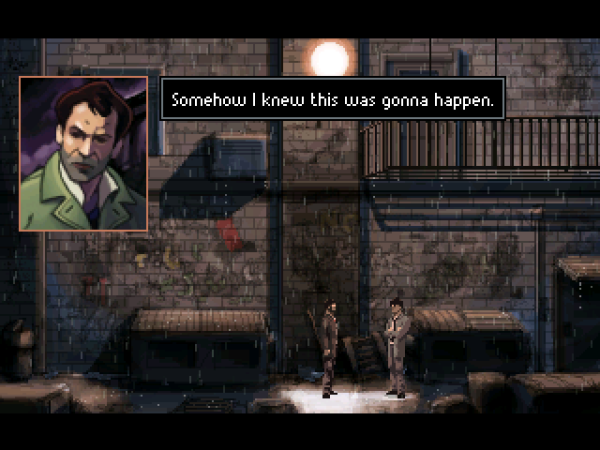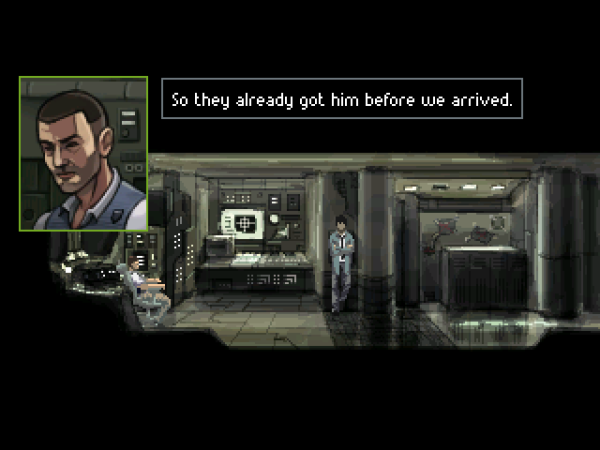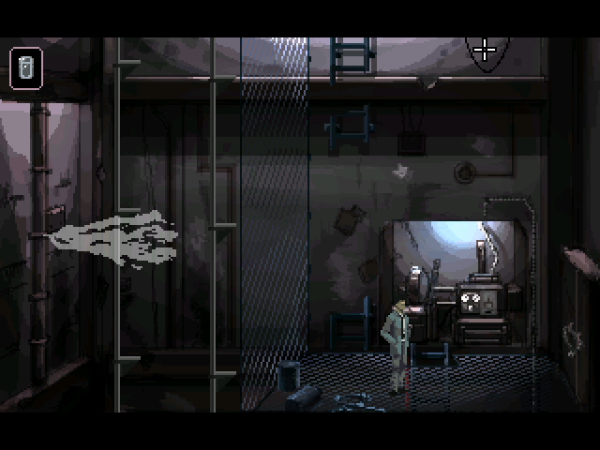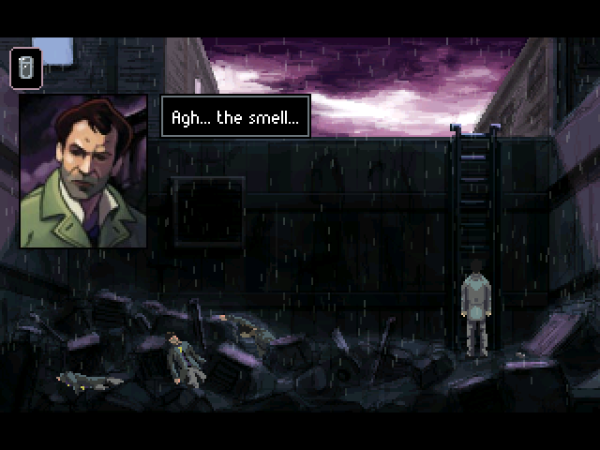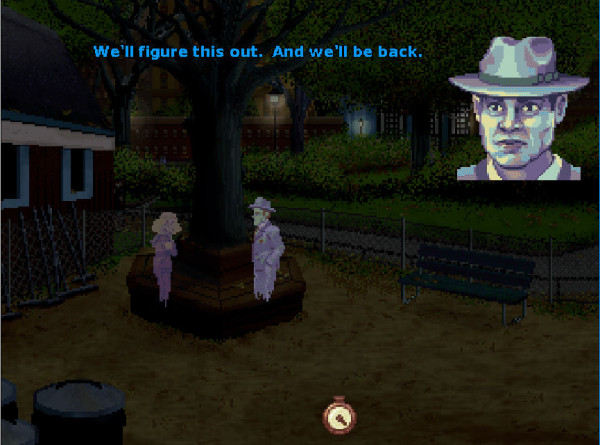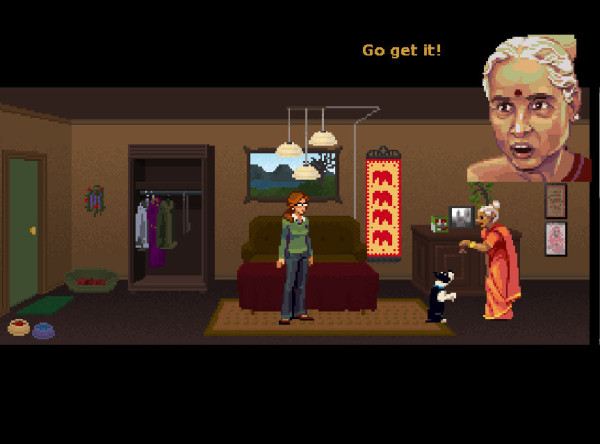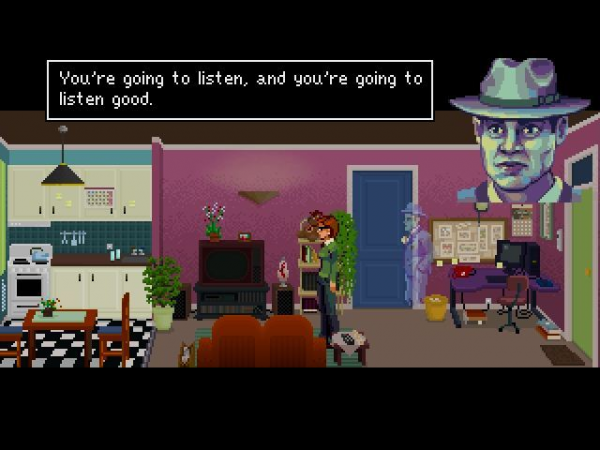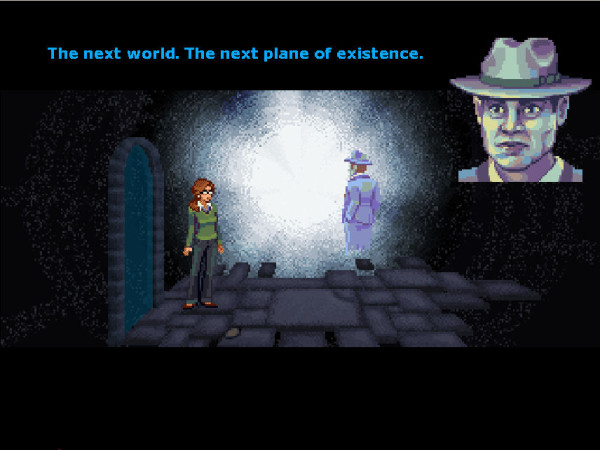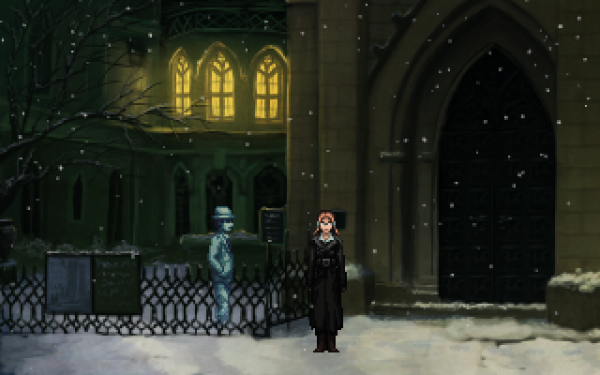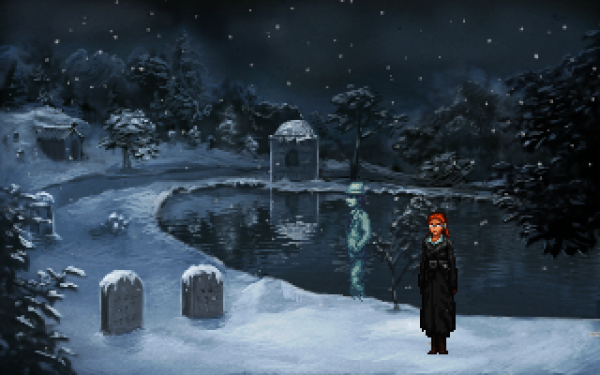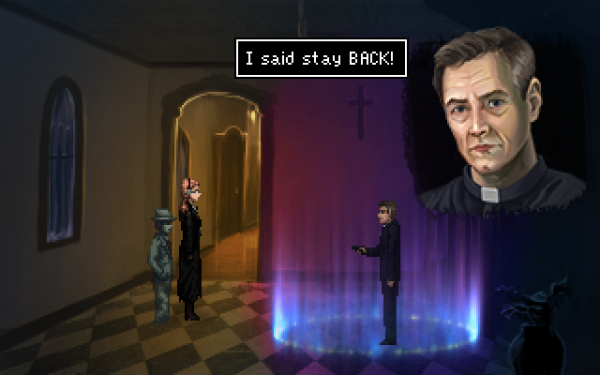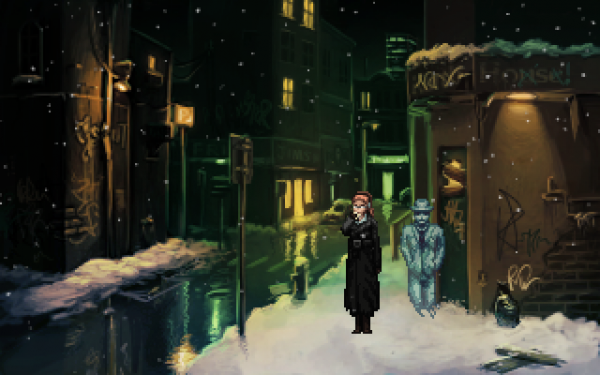The Wadjet Eye Blog
Children’s television and presidential candidates
Like any parents of small children, we have been exposed to LOTS of children’s television. And like any parent in this situation, we have to invent little mind games to prevent ourselves from going crazy.
My current mind game: analyzing the attributes of each show our three year old Eve watches and matching them with the current presidential candidates. Since talking about the election is click-bait galore, I’ve decided to post my findings here. Enjoy.
Show #1: Daniel Tiger’s Neighborhood
Daniel Tiger is the followup to Mr. Roger’s Neighborhood, and the pitch is basically “The Land of Make Believe: The Next Generation.” Eve loves loves loves this show. It was the first show she watched and she always comes back to it. She’s seen each episode like ten times.
Like its predecessor, Daniel Tiger tries to teach kids about their feelings, having good manners, and how to be nice and kind. It’s an ideal world that you can’t help but wish existed, but you know deep in your heart that it doesn’t. This is reinforced when your kid is throwing a tantrum and you try to try to sing the “When you’re feeling mad” song from the show and can barely get to the third word before their screams drown you out.
So to recap: an idealist whose ideas you really want to work but probably aren’t practical, and who the kids also love:

Daniel Tiger is Bernie Sanders.
Show #2: Bubble Guppies
Eve was obssessed with this show for months. So much so that the word “bubble” became her word for television. I’m glad she went off of it, because this show has the potential to break your brain.
The show is about a school of mermaid children. They sing. They learn lessons. They go camping, they go sailing, they go on airplanes… and yes, this show takes place underwater. It’s almost like the producers of the show decided to set the show underwater in the middle of production but didn’t tell the writers. Nothing these kids do make any sense. There’s no internal logic. One minute they just swim over a house, the next minute they need a ladder to reach a window. It’s pure spectacle with only a thin veneer of pretending to teach you.
Recap: makes no logical sense, does whatever the heck it wants to at any given moment, held together by pure spectacle, and yet inexplicably remains popular.
No contest.

Bubble Guppies is Donald Trump.
Show #3: Tumbleleaf
My wife and I really like this show. It’s calm. It’s gorgeously animated. It’s well put-together. It teaches lessons about problem solving in a straightforward, logical and entertaining way. It doesn’t treat kids like idiots. It’s probably the only show that we’ll willingly sit down to watch with Eve. There’s only one problem. She never wants to watch it.
In a nutshell, this is a perfectly reasonable show that very few people care about.
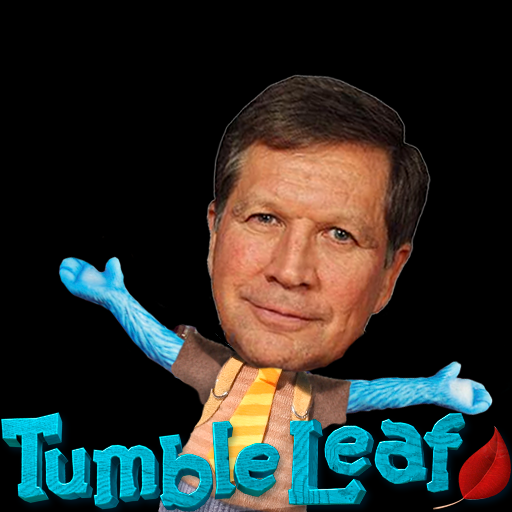
Tumbleleaf is John Kasich.
Show #4: Caillou
Oh god, this kid. Go to any parenting forum and everyone will universally agree. Everybody hates Caillou. He’s annoying. He’s heavily moralizing. His voice makes you want to punch him after five seconds. Oh, and he’s from Canada too.
The answer is obvious.
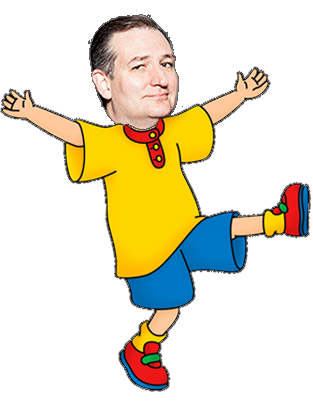
Caillou is Ted Cruz. You might hate him, but it’s better than letting Bubble Guppies teach your kids.
Show #5: Dora the Explorer
A classic. Everyone knows Dora. Eve loves Dora, and especially digs her monkey partner Boots. Dora’s been around for a long long time. She’s helpful, she’s hard-working, she’s tireless. But at the same time, she’s kind of over-exposed. Her “brand” has been carefully managed and presented. When you watch the show, you can’t help but think that every word, image and animation had to pass through a series of marketing and PR meetings. She’s been around so long that you might be a little sick of her. And she’s become so corporate that maybe you don’t really trust her anymore.
She is experienced, closely aligned with corporate interests, and partnered with a guy that occasionally hogs the spotlight.

Duh. This stuff writes itself.
-Dave
Post-Mortem: A Golden Wake
In roughly mid-2008, I decided it was time to finally realize my ambition of becoming a commercial indie developer. I had been developing freeware point and click adventure games for the past 7 years, and found myself dedicated to completing an 8-part series which I knew had to be completed before starting any new projects, if only for my own peace of mind. In the meantime, I began brainstorming ideas for the next game I would do, the one that would be my big break into the commercial scene, the one that would put me on the map and make me a comfortable living doing what I wanted. I may not have made the perfect adventure game, but A Golden Wake taught me some very valuable lessons, as well as got me started on my ideal career path.
POST-MORTEM: A Golden Wake
In about 2009, I began thinking about what sort of game I would do after completing my freeware Ben Jordan series. I’d had a few dud ideas, including one about a trilogy of games where the same story was told from the perspective of three unlikely protagonists: a wealthy socialite, a freelance artist, and a male prostitute, all set in my hometown of Miami, Florida. Upon reflection, it dawned on me that these games were really more style over substance, focusing more on the fact that the protagonists came from walks of life not often seen in adventure games instead of the story itself, which, though not fully designed, didn’t strike me as anything special.
So I went back to the drawing board, preserving some ideas from that failed project, namely the unorthodox character professions and the real world setting. I drew some inspiration from Dave Gilbert’s Blackwell series, specifically Blackwell Convergence, in which a key plot point involved some obscure yet fascinating local New York history. Having always been intrigued by the history of Miami, specifically its establishment and growth in the early 20th century, I began doing some research into the Florida Land Boom of the 1920s. From there, things snowballed: I would make my game about a real estate agent who tries to make it big in the 1920s. I figured it would be my chance to do historical fiction, set in a time and place not commonly talked about, with an unusual protagonist. It had all the makings of something interesting, and so I began to design what would later become known as A Golden Wake.
THE GOOD
I think where A Golden Wake succeeds the most is in establishing a sense of time and place. I spent a lot of time researching the era, from the clothing to the architecture to the music to the slang, and really wanted to get it right. I took heavy inspiration from L.A. Noire, which, for all its flaws, did an excellent job of making you feel like you were in 1947 Los Angeles. I wanted anyone who played the game to feel like they really were in 1920s Miami, so my goal was to make the game feel as authentic as possible.
One of the biggest tricks was getting the manner of speech right in dialogues. Obviously, people spoke differently back then, but cramming some slang word or phrase in every single sentence would make it feel artificial and forced. I decided to limit it as much as possible and take a “less is more” approach, with the main indulgence being main character Alfie Banks’ proclivity to exclaim “Horsefeathers!” when upset. The mobsters in the later half of the game also tend to speak with a fair amount of slang, although I tried not to make them the sneering caricatures from Looney Tunes. All in all, I think I struck a decent balance, as several comments regarding the game praised it for its authentic feel.
The music was also something that really shines in the game. I worked with Pete Gresser, who had done the scores for the last 3 entries in my freeware series Ben Jordan: Paranormal Investigator, so having a good working relationship and ease of communication was extremely helpful. We were both excited about the prospect of getting to do a 1920s jazz influenced score, which I also felt would add significantly to the game. In the initial phases, we spoke about having a live clarinetist on the score, but in the end we decided against it for both time and budget reasons, opting instead to use a fully digital score, albeit with a sound library specifically designed for jazz and era-appropriate instruments. This attention to detail really brought the score together and boosted the game’s atmosphere.
THE NOT SO GOOD
In constructing the story for A Golden Wake, I wanted to be as historically accurate as possible. The result was a narrative that wove actual events into the story of Alfie Banks and his rise and fall in the real estate world. However, one issue with the game’s story was that I stuck a bit too close to historical events, at times putting them ahead of Alfie. For example, the story begins in 1921, but major events such as the incorporation of the city and the first big hurricane didn’t occur until 1925 and 1926, respectively. As a result, there is a large jump in the narrative of 4 years during the game’s second chapter, which I think many players felt was jarring. Also, Alfie himself wasn’t as well-developed as he could have been. There are multiple ways this could have been solved, from expanding upon the relationship between him and his brother, to adding a rival in the real estate office for him to go up against, but ultimately I made the history of Coral Gables priority #1, which resulted in Alfie’s story being somewhat lacking. Interestingly enough, this was one of the more polarizing aspects of the game. Some players loved the story and Alfie, while others found both bland and boring.
The game’s difficulty was another point which wasn’t as balanced as it could have been. In trying to stay grounded in reality, I made the puzzles as logical as I could, which resulted in most of them being extremely easy. On the other hand, I wanted to try something outside of the box with the idea of the persuasion puzzles and Seller Intuition. This system went through some major tweaks, and while they turned out much better than originally executed, they wound up becoming more of an exercise in trial and error than a rewarding puzzle. The main issue was avoiding having the correct answers seem extremely obvious, and thus removing all challenge from the puzzles, but in the end the challenge of figuring out the best answer became somewhat muddled.
FINAL THOUGHTS
All in all, I’m proud of A Golden Wake. I knew from day one that it was going to be a hard sell, and not a game for everyone, but I was given the opportunity to get the game out into the world, and ultimately accomplish what I set out to do. During the process of researching the game, I remember feeling genuinely excited about the idea of telling this story and virtually roaming the streets of 1920s Miami. To see it all finally come together was an absolute treat. Despite its flaws, my vision for the game was kept intact, which I feel is the most important thing of all. I’m grateful to Wadjet Eye Games for publishing it, and to everyone who played it. It was a fantastic learning experience and a great stepping stone for what will hopefully be a long career of adventure game development.
In search of Joe Gould – part 1
Blackwell fans probably remember the characters of Joe Gould (the West Village bohemian who wandered around gin mills in the 50s and was trying to write the Oral History of Our Time) and Joseph Mitchell (the New Yorker reporter who wrote a piece about Gould, then mysteriously stopped writing but continued to work at the paper for 30 years). In Blackwell Convergence, you could go to a tavern named the Minetta and look at Joe Gould’s portrait hanging on the wall.
What you might not know is that Gould, Mitchell, the Minetta, and the portrait actually existed.
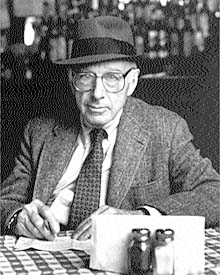

The real life Mitchell and Gould.
I won’t go into detail about their lives here (that’s what Wikipedia is for), but something about their stories absolutely fascinated me. I can’t explain it. I was absolutely inspired. In my early days as a developer I would spend long afternoons in the Minetta, sitting under the Joe Gould portrait, hashing out the plot details for the whole Blackwell series. It’s no wonder that the two men ended up being featured so heavily in the story.
In 2008, the Minetta underwent massive changes. It was bought out, gutted, and completely renovated. It’s fancier and much more expensive now. You need to reserve your table several weeks in advance if you want to walk through the door. Suffice to say, I don’t do my design work there anymore.
Flash forward a few years later. My wife and I decide to go there on our anniversary. We make the reservations well in advance, we dress nice, we enter the place… and the Joe Gould portrait is gone. Not just moved to another spot, but gone.
I asked the hostess where it went. She didn’t know what I was talking about. I asked the waiter. He knew nothing either. I asked to speak to the manager. He dutifully came to my table and told me that there was no such thing. Nobody at the restaurant ever heard of the name “Joe Gould”, let alone know where his portrait might be.
This was a mystery. One that has bugged me for several years. I let it go as just one of those things, but then last week I had enough. My epiphany (ahem) was triggered by reading a wonderful biography of Joseph Mitchell (called “Man in Profile.” Read it. It’s excellent) and it got me wondering again. Where did this portrait end up? I simply HAD to know.
So today, I decided to try and search for it. And since this is the age of sharing, I will be keeping a record of my search on this website:
THE SEARCH FOR JOE GOULD – Day 1
10am
I only knew one thing – the Minetta was bought and renovated by the Keith Mcnally Restaurant Group. The first step seemed obvious – call the Keith Mcnally Restaurant Group and ask them. So like the dogged investigator that I am, I typed “Keith Mcnally Restaurant Group” into Google. This resulted in a bunch of restaurants that belonged to the group, but no results for the group itself. Trying various permutations of the search string did not help. All I could find was the wikipedia entry for Keith Mcnally himself (he was born in London and moved to New York City in 1975, by the way) but nothing about how to contact him or anyone from his company.
So, it’s back to the source. Even though nobody working at the Minetta could remember that the Joe Gould portrait even existed, somebody there OUGHT to know who the restaurant’s current owners are and how to contact them. So I called up the restaurant and navigated their phone menu. I eventually found my way to the General Manager’s voice mail and left a message explaining what I was trying to do. Since the manager’s voicemail message was “Greeting 3 not recorded. BEEP!” I’m not hopeful that this call will be returned.
1pm
I try calling again and get the same result. On a whim, I call back, but instead of choosing the “General Manager” option, I choose “Reservations.” This, I figure, will at least get me through to a human being. Success! I explain my situation to the reservations guy (who, naturally, had never heard of the Joe Gould portrait). He told me that the reason why I haven’t been able to reach anybody was because the restaurant was closed for lunch on Mondays and Tuesdays. “Call back at 4:30,” he told me. “Someone should be able to help you.” Righto. I hang up. Guess I should do some work on Technobabylon or something.
5pm
I call the Minetta and try the General Manager again. “Greeting 3 not recorded. BEEP.” That’s a big nope. I call back and try reservations. I got a different person this time, and so I begin my spiel. Here’s a rough version of my conversation:
Me: Hi. I’m hoping you can help me out with a bit of a mystery. I’m looking for a painting that used to hang in the Minetta, before the big rennovation. The painting of Joe Gould? Have you ever heard of it?
Guy: I’m afraid not. I only just started working here.
Me: That’s okay. I tried calling the Keith Mcnally Restaurant group, but I can’t seem to find a number for them. I was hoping someone at the Minetta could help me.
Guy: Well you’re in luck. This number handles calls for Keith Mcnally, but we can’t give out their phone number.
Me: Oh.
Guy: BUT – this does sound fascinating. You’ve got me curious as well. Give me your name and number and I’ll ask around the office.
Me: Oh. That’s great! Thank you very much.
Guy: I’ll give you a call back in a few days.
So… that’s where things stand now. Will update again once I know more.
-Dave
Let’s talk Steam Spy
Hi all. Dave here. It’s been awhile. We’ve been plugging away on Technobabylon and haven’t had a lot of time for blogging, but there’s been a new development recently that I Have Thoughts about. Thoughts that can’t be encapsulated in a 140 character tweet.
You might have heard about this new thing called “Steam Spy.” It pulls user data from Steam and allows anyone to see the number of people that own any particular game. What that means is that it lets you see the Steam sales statistics for any game that’s on the service.
Everyone is lauding it as this Awesome Thing, but I have to be honest – I am super conflicted. For most of Wadjet Eye’s existence, the majority of the profit went to me and my wife. So giving away sales stats was the equivalent of letting you peek into my bank account to see how much was in there. We are fairly private people, and giving away that kind of personal information was just not something we were mentally prepared to do. Even now, with several developers and two full-timers on our payroll, we aren’t comfortable with it.
So hello, Steam Spy. I guess that’s all changed. This is the new reality and I suppose developers like me will have to adjust. Fortunately, the service only gives the number of sales and not the actual money that exchanged hands. Unfortunately, this has the side effect of people looking at our sales stats and doing comparisons and adding things up and trying to determine how much money we have. Some are even going as far as to ask me personally if their estimates are correct. Some expressed worry that we are going out of business. So… yeah. Exactly the kind of speculation I wanted to avoid.
BUT, if this is the new normal, I will have learn to embrace it. So let’s nip all this speculation in the bud and discuss these sexy Steam Spy Stats:
Gemini Rue: 230,524
Blackwell Legacy: 118,446
Resonance: 47,760
Blackwell Deception: 68,138
Primordia: 57,949
Golden Wake: 15,920
Blackwell Unbound: 101,889
Shivah: 82,785
Blackwell Convergence: 98,705
Blackwell Epiphany: 7,005
(source HERE)
There is some margin of error and not all of these numbers are accurate, but they are close enough. Also, it’s very important to remember that Steam is not the only distributor out there. There’s GoG, direct sales, and various bundles like Groupies. So these numbers are in actuality much higher. But for the sake of simplicity, I am going to use ONLY numbers that are available publicly via Steam Spy and nothing else.
Looking at that list by itself, it’s easy to make some assumptions. Number one, it looks like Blackwell Epiphany totally tanked when compared to everything else. And yet, I have gone on record saying that game was our most profitable. So what gives?
First of all, remember the age we live in. This is the age of bundles, extreme discounts, and rock bottom sale prices. The older the game, the most likely it has been on sale a number of times, or been in a bundle. All of our games have been in various holiday deals, Humble Bundles, flash sales, and so on. So it’s only natural that their sales numbers are significantly higher, but it’s important to remember that those games were sold with steep steep discounts during that time. In some cases as low as a penny a copy during a bundle sale!
Blackwell Epiphany, on the other hand, is still fairly new and has NOT been in any major sales yet. So 7,005 copies were sold on Steam at retail price or close to it. So if you do the math… 7,005 copies at a cost of $14.99 each… it yielded us a gross profit of $105,004.95 for that game alone. That amount will only jump higher once it starts the rounds of sales, bundles, and promotions. Also helping us is that Blackwell Epiphany is a game we own, versus one we publish; so there are no developers to give royalties to and all of that money stays right in our coffers. We’re a small mom and pop operation, so that money goes a long way. None of our other games earned us that amount of money so fast without going on sale first, so that’s why I’m not lying when I say Blackwell Epiphany is our most profitable game.
Nobody knows more than me how easy it is to collate data, study it, compare it, and then come to the absolute wrong conclusions. I’ve discussed this before, but there are several other instances of me being SURE I cracked some kind of code and then getting bitten in the butt because of it. This new data trove is no exception. Steam Spy is a useful tool, there are many many unknown factors to consider.
Anyway, the data is out there now. If anyone has any questions about it, feel free to ask!
-Dave
Designing a World – Lessons Learned
If there’s one thing we all know about adventure games, it’s that they depend heavily on characters, story, and an interesting location. Ideally, they’re not just games, they’re new worlds to explore. So, how do you design one effectively?
This is a lesson I’ve had to learn a lot about lately. In my previous games, the setting was always in the real world. I didn’t have to do a whole lot of work because the places were real: they had history I could draw upon and add my own elements to, but most of the hard bit was already done for me. With Shardlight, I’ve had to design a world from the ground up, which has proven to be more challenging than I could ever have expected.
It’s easy enough to say “okay, this is a city and this is happening and there’s these types of people living here,” but sometimes that might not be enough to be convincing. For example: I designed a puzzle that requires the character to travel to an abandoned factory, but aside from seeing that it was abandoned and having an item necessary to the puzzle in it, there was really nothing else to make it feel like a real place. It could just as easily have been an empty field with said item in it, that’s how boring it was. At Dave’s suggestion, I went back and wrote a very basic story for it, and just doing that has made the place way more interesting and tie into the world much better. It now feels like a place with a purpose that can be explored, rather than a perfunctory room in an adventure game.
This is why it’s not just enough to write the story of your game, it’s extremely important to write the story of your world and what happened before the events of your game. My main concern is overdoing it. You don’t want to have a world with such a rich lore and history that it takes hours to just establish why your main character’s house has a leak in the roof. One thing I’ve learned is that not everything needs a complex backstory. Life is mundane, and parts of your environment can be too. Of course, don’t make it TOO mundane, or else you might as well be walking around exploring your own world rather than escaping to one in a game.
So long story short: figure out where your story takes place and write a little history for it. It’s fun to create a world from scratch because you can do whatever you like! Remember that the majority of what you write won’t actually wind up in your game, but having it in your mind is of the utmost importance to create a convincing world.
-Francisco
Female characters, marketing, and consistency of design
Hi all! Dave here back with another edition of blog. Today I’m going to talk about something that’s not terribly current, but should always be relevant.
Last summer, Ubisoft caused a bit of a kerfuffle when they announced that there wouldn’t be a female playable character in Assassin’s Creed: Unity’s co-op mode. Their reasons? It was too much work and it wasn’t worth it. This led to many great debates and discussions about female representations in video games, none of which I will get into here. I know this is very old news, but please bear with me. Suffice to say, I have been asked several times about my position and opinion on the whole “female characters in games” thing. So after hemming and hawing about it for awhile, I have decided to finally address this topic.
First of all, why is my opinion so important? It probably has to do with Blackwell, our flagship series. As you probably know, the protagonist of Blackwell is Rosa Blackwell, who is – *gasp* – a woman. Going by what the AAA industry would have us believe, this should have killed the series before it even began.
In all honesty, I did not set out to create a female character. I just wanted to create a character. I set out to create a quintessential New York type of person – intellectual, neurotic, perhaps a bit aimless – and that’s what I did. I created Rosa Blackwell, paired her up with Joey, and The Blackwell Legacy was the result.
This game launched in 2006. I won’t say that the original game was a huge seller, but it was reviewed nicely and sold well enough to pay all my bills and keep me in business. There were five games in the series (the last of which was released in April of this year), and each installment sold better and was reviewed better then the last, despite having a woman (a sensibly-dressed woman no less) on the cover. So… yeah. Way to show those AAA marketing people, eh? They obviously don’t know what they are talking about, right? Who says you need a male protagonist in order to sell?
Let’s shift gears a bit. In 2011 we took a break from writing our own stuff and published a game called Gemini Rue. You might have heard of it. It was the biggest seller in the history of our company. It was the first game of ours to be featured at the IGF. It was the first game of ours that caught the attention of major “hardcore” sites like Kotaku and Giant Bomb. It was the first game of ours that really put us on the map. It was the first game of ours to break us out of the adventure gamer niche and into the mainstream.
Oh, and it was also the first game of ours to feature a serious-looking white male as the protagonist. One who is unshaven, speaks in a growly gravelly voice, carries a gun, and is several hundred shades of cynical and grim. So… yeah. Basically the epitome of the AAA mass-marketable character.
So what did this teach me? Were all those AAA marketing people right? Was I shooting myself in the foot by making not only a game starring a woman, but a whole game SERIES? Okay, fine. Blackwell was selling fine – flourishing, in fact! – but maybe they would be selling exponentially better if the games starred a man instead? I mean, maybe those big companies knew what they were talking about. They have bigger resources then me. They have whole teams dedicated to learning this stuff. If they spent all that money, sorted through all that data, and came to the conclusion “male characters sell better,” who am I to argue?
I admit this caused a bit of an existential crisis for awhile. I was in the middle of working on Blackwell Deception, and I was terrified. Did I make a huge mistake back in 2006 when I started this series? I had come this far, and I was beginning to doubt myself. It would have been SO EASY to leap to the obvious conclusion (that male characters sell better) and leave it at that, but I wanted to find out for myself.
So I went to the fans directly and asked the obvious question: “So why did you choose to play Gemini Rue instead of Blackwell?”
The responses were… interesting to say the least.
- I just love cyberpunk!
- I don’t want to commit to an entire series. I just want one game.
- I played the demo of the first Blackwell and I didn’t like it much.
- Ghost stories don’t interest me so much.
- Gemini Rue just looked more my thing.
There were many more responses then this, but they were all various offshoots of the above. And only a negligible few said anything about the characters. Barely 1%. Hardly anyone cared that Azriel was a “badass”, and hardly anyone cared that Rosa was a woman. That didn’t seem to be the issue. At least, not enough to make a significant difference.
It was never about the gender of the protagonist. It was about the game.
On the one hand, you’ve got Gemini Rue. Here are some screenshots that were used heavily in the marketing:
You look at those, and you know what you’re getting. It’s a dystopian future. It’s raining. There are spaceships. There are guys in trenchcoats. You know it. You get it. You might think of Blade Runner or Cowboy Bebop when you look at those screenshots. Those things are very popular. There’s a very good chance you like them too, so you are willing to take a chance on liking this.
Now, for comparison, let’s look at the first Blackwell game:
So there’s a redhead lady. And a ghost. You might think of TV shows like Medium or Dead Like Me. Popular enough in their way, but very niche. There they are in a living room. And some kind of park? Oh, and you get to feed a dog? Is that what you do in this game? The locations are… well, kind ordinary. Nothing interesting is happening in them. There’s one shot where they are in some kind of otherworldly place that could be kinda cool, but it’s so out of place that it becomes an exception rather than the rule. You’ll probably give this game a glance and move onto something else. Maybe you’ll read a review of the game later and it is positive, so maybe you’ll give it a try. That is, if you remember.
I am being my own worst critic here. But the truth of the matter is that a game like Gemini Rue totally sold itself. It was EASY to sell that game, because it compressed well. You got the “message” of what it was about very quickly. Blackwell was… less so. I had a very concrete idea of what Blackwell was – it was a dark urban fantasy! – but my inexperience as a designer and a marketer prevented me from really getting that across. As a result, nobody knew what Blackwell was.
It took me several years before I figured this out. And it is no coincidence that Blackwell Epiphany (the latest and last game of the series) was designed from the ground up to make the “message” of the game crystal clear:
So you’ve got snow. Not just snow. COLD. We wanted you to feel it when looking at it. You’ve got urban environments and decay. An otherworldly atmosphere pervades over everything. The magical glowy effect on the lower left? It doesn’t look out of place because the whole game has a consistent magical feeling. This game might not remind you of anything specific, but you take one look at these screenshots and you know exactly what you are getting: a dark urban fantasy, which is exactly what Blackwell is.
The message was clear. And was understood. And sure enough, the sales reflect that. Blackwell Epiphany’s one month sales figures were higher then all the other Blackwell’s one month sales figures put together.
So what’s my point? Gender has nothing to do with a game’s sales performance. It has everything to do with how a game is designed, presented and (yes) marketed. Turning Rosa into Ray would not have helped Blackwell magically sell better, but digging down and making a better designed and consistent GAME? Yes. That’s what matters.
In any case, I’d love to hear if my thoughts echo your experiences when it came to buying our stuff. Please let us know in the comments!
-Dave
I draw. I talk:
Hey there, I’m Ben, and I’m an artist with Wadjet Eye Games. I’m going to have a quick break from drawing pictures to talk about drawing pictures.
“Storytelling” is much more than the plot of a game, and the words used to convey it. A game’s story is told in its writing, but also the acting that delivers it, the music, the way you interact with the game, and most importantly for my interests, the art. Imagery is an essential element in world building, the creation of atmosphere and the development of a story’s characters. Good art can not only support a game’s writing, but also allow it to come across more vividly, to bring the words to life.
My initial motivations for learning to draw were quite simple – making things look good was cool and I wanted to be like the people who could do it. I viewed art entirely as a talent; not technical ability that one can learn and refine, not as a means of communicating an idea or message, but as some magical thing which let the lucky people draw well. I failed art in the 11th grade because of this misunderstanding – I wanted to learn how to draw just by drawing a lot, they wanted me to learn how to look at things and how to express myself. I was naive and impatient*.
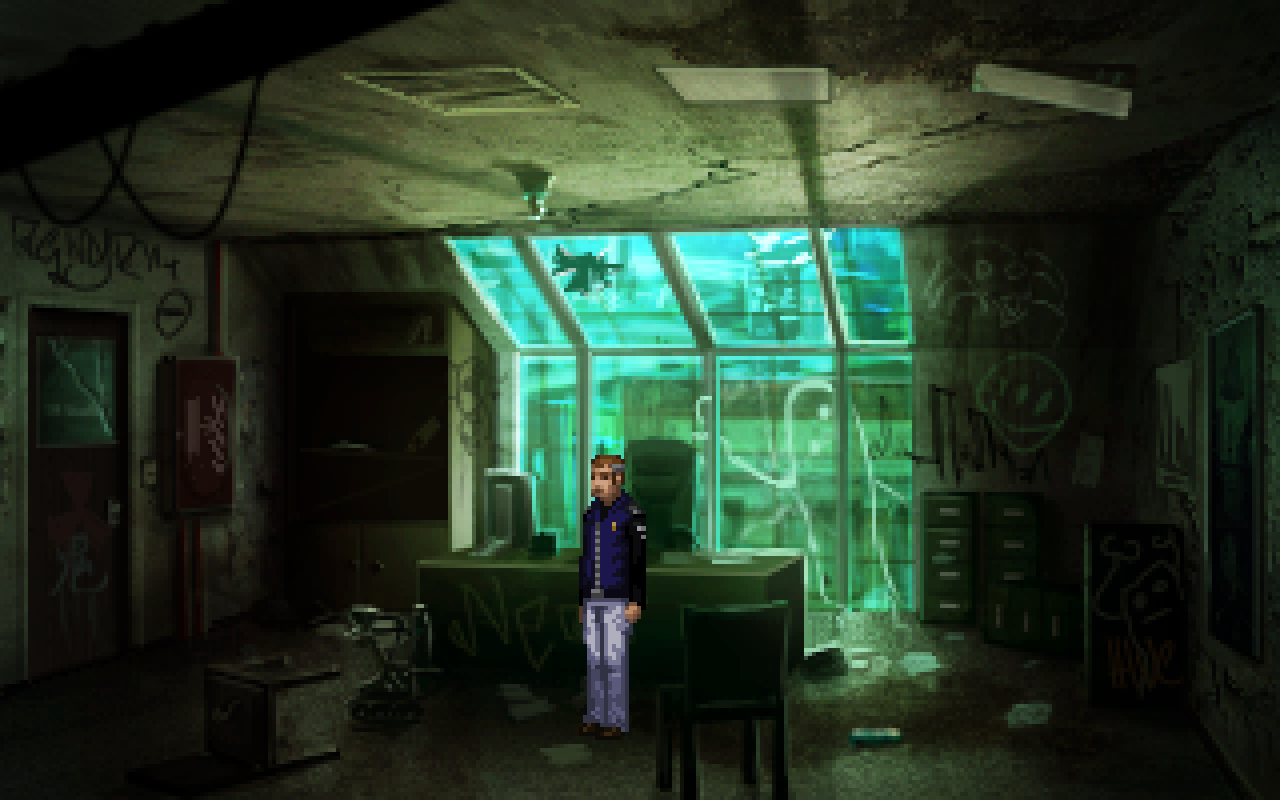
When I started drawing for games my approach was also very direct and basic. Certain adventure games look good, so I wanted to draw games that look like them. I had very little discipline and no real message I was trying to convey, or understanding of why those games look good, so I just muddled my way through, hoping for the best. Eventually there came a point where I could draw a little bit and I wanted to further my abilities, and I started thinking about why I was making certain choices and how they’d affect the games, analyzing why the images I liked appeal to me and what they bring to the games as a whole. I didn’t just want to make things look nice anymore – I wanted to tell a story.
Working on Blackwell Epiphany with Dave was a great chance to explore this. I love working with Dave because – especially these days – he really focuses on the characters in a scene when he writes. I never get a sense of “We’re only going here because it’s a puzzle” when I read his scripts and play the games, he writes to tell us a story, let us explore the world. This is great for me because, although his sketches are very simple and he basically relies on the artist to add detail to a scene, I always know exactly what sort of mood a place has, what sort of atmosphere he wants for the story, and that gives my mind something to work from, a direction to focus on when I draw.
This can affect things like colour choices, the brightness of a scene, the general composition and even what details make up the scene themselves. A wilted flower in a vase, a snowman that’s fallen out of shape, a dirty old mattress on the floor – these things all help convey little elements of a story to the player. I often think about building adventure game backgrounds as being similar to playing The Sims; these places have people living in them, and I furnish and embellish them in a manner that suits their personality and their story. Don’t just tell the player “this person is a slob” – make it completely apparent from their dwelling so the player knows that as soon as they walk in.
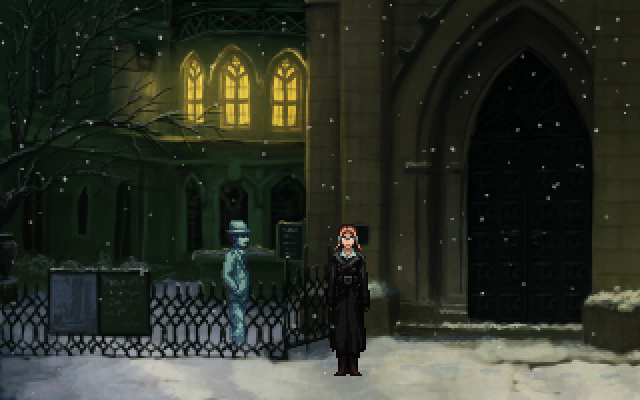
That, for me, is the “why” behind art. I no longer approach drawing with the mindset of “I want to make a game that looks cool.” The art of a game is a means for delivering story, for creating a world. I’m no longer the 15 year old kid who wants to draw swords and robots just because they look cool to me; I want to help the writer tell their tale and, most of all, build worlds. I can do that with art, and that really excites me. I can’t discuss a story or game world with someone without my head being filled with visions of what would suit this, what I could do to help flesh out the world. It’s inspiring to have that sort of chance to create things.
Of course, making things look nice is rewarding in its own sense. Being able to render an image accurately takes patience and skill, and can be very satisfying, but this ability to evoke emotions with my images is why I’m here. I’ve really enjoyed helping Dave and James to craft their worlds in Blackwell Epiphany and Technobabylon, and I look forward to showing you some of the world I’m currently building with Francisco on Shardlight. We have so many stories to tell. I look forward to having you along for the ride.
Greetings from Grundislav!
Hello all!
This is Francisco Gonzalez (aka Grundislav,) and I’ve been given access to the Wadjet Eye Games blog, so I figured I’d take this opportunity to say a quick hello and introduce myself to anyone who might not know who the heck I am.
Long story short, I’ve been using Adventure Game Studio to make games since 2001. Over the past 13 years I’ve released over 20 games, most notably the Ben Jordan series. In 2014, I released my first commercial game, A Golden Wake, published by Wadjet Eye. A short time later, Dave and Janet were kind enough to offer me a full time position at the company as a game designer.
Currently I’m working along with Ben Chandler on a game called Shardlight, which you’ll be hearing more about later this year, and after that…who knows! I’ve got plenty of ideas and am really excited to be a part of a company that’s put out so many amazing titles. This truly is a dream job which I am extremely grateful for, and I can’t wait to see what the future holds.
See you all soon!
– Francisco

